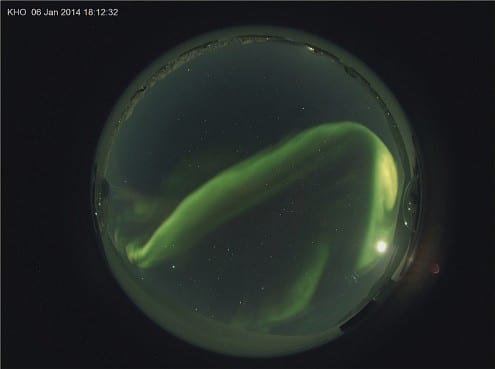Observing the eclipse in Svalbard
By Oli Usher, on 1 April 2015

The observatory during the solar eclipse. Photo: : Noora Partamies / Kjell Henriksen Observatory, The University Centre in Svalbard (free for non-commercial use)
The eclipse might have been underwhelming in London. But in Svalbard, a Norwegian archipelago far north of the Arctic Circle, the skies were clear, and the eclipse was total. Sitting on a hillside ten kilometres outside Longyearbyen – the northernmost town in the world – is Kjell Henriksen Observatory.
UCL’s Atmospheric Physics Laboratory has instruments at the observatory – and during the eclipse, three UCL scientists (Anasuya Aruliah, Ian McWhirter and PhD student Amy Ronksley) operated them remotely from overcast London.
The instruments study the properties of the uppermost reaches of the Earth’s atmosphere. Near the north and south magnetic poles, Earth’s magnetic field plunges into the atmosphere. The charged particles of the solar wind which are deflected before reaching the atmosphere in the rest of the world are able to interact with atmospheric gases here.
These interactions lead to the phenomenon known as the aurora borealis – or northern lights – and their southern counterparts.

Aurora observed from the observatory during night-time hours on 6 January. Credit: UCL Atmospheric Physics Group (CC-BY)
UCL’s instruments at the observatory measure winds and temperatures at an altitude of 240km, where the air is only one ten billionth the density of that at ground level. They do this by detecting the wind’s effect on the aurora.
The two main components of the aurora are green light, produced at an altitude of 90km, and red light, at 240km altitude. Both come from oxygen atoms whose electrons have been excited by the solar wind. As the electrons return to their usual orbits, they produce light of extremely precisely defined colours – much like neon signs or lasers do.
These colours let the scientists determine the speed and temperature of the gases in the upper atmosphere.
They determine the speed by observing how the colour shifts almost imperceptibly towards blue or red, when the wind is blowing towards or away from the observatory. (This phenomenon, known as the Doppler Effect, is also what causes the shift in the pitch of an ambulance siren as it drives past.)
They determine the temperature thanks to the oxygen atoms’ vibration. As the atoms vibrate to and fro, a miniature Doppler Effect makes the light appear slightly redder for the time the atom is moving away, and slightly bluer for the time it is moving towards the observer. This means the light is no longer a perfectly pure shade of red, but encompasses a tiny range of colours – a process known as spectral broadening. The hotter a gas is, the greater the movement, and the greater the spread of colours.
By measuring Doppler shifts and spectral broadening, the UCL instruments produce a complete weather map for the atmosphere at the edge of space.
Alongside the instruments is a colour camera with a fisheye lens, which can see from horizon to horizon, and which produces photos such as the one shown above.
Such measurements can only be done at night, not just because the auroral emissions are swamped by sunlight during the day, but because the sensitive cameras in the instruments would be damaged by sunlight. The eclipse provided a unique, albeit brief opportunity to observe during daytime. Preliminary analysis of the data has indicated strong daytime winds in the upper atmosphere during totality.
And although the scientists weren’t able to see the aurorae they hoped to catch a glimpse of, a fisheye picture they took during the eclipse does show how a small ‘umbrella’ of darkness sat directly above Svalbard, while bright sunlight was visible on the horizon in all directions.

The sky above the observatory during the eclipse – a ring of sunlight can be seen around the horizon. Photo: UCL Atmospheric Physics Group (CC-BY)
As well as simple scientific curiosity, scientists study the uppermost reaches of the atmosphere (known as the thermosphere) for some very practical reasons. Most satellites orbit within this region, and better data on its properties can help engineers plan their orbital corrections and manoeuvres. Moreover, the interaction between the thermosphere and the solar wind is also a key element of ‘space weather’, which can disrupt electrical and communications infrastructure on the ground.
The information gathered by atmospheric physicists at UCL and elsewhere is helping to improve the computer models of how the upper atmosphere behaves, so that we can better understand these phenomena.
Related links:
- Reports from the team on the UCL Astrophysics Group website
- Kjell Henriksen Observatory on Facebook
- University Centre in Svalbard
One Response to “Observing the eclipse in Svalbard”
- 1
 Close
Close



Absolutely fantastic read and awesome photos. Need I say that I was unable to see the eclipse due to the notoriously grey skies of the UK